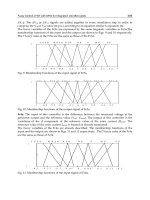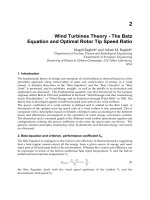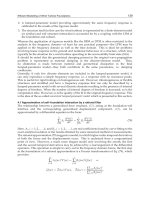ADVANCED TOPICS IN APPLIED OPERATIONS MANAGEMENT potx
Bạn đang xem bản rút gọn của tài liệu. Xem và tải ngay bản đầy đủ của tài liệu tại đây (5.66 MB, 210 trang )
ADVANCED TOPICS
IN APPLIED OPERATIONS
MANAGEMENT
Edited by Yair Holtzman
Advanced Topics in Applied Operations Management
Edited by Yair Holtzman
Published by InTech
Janeza Trdine 9, 51000 Rijeka, Croatia
Copyright © 2012 InTech
All chapters are Open Access distributed under the Creative Commons Attribution 3.0
license, which allows users to download, copy and build upon published articles even for
commercial purposes, as long as the author and publisher are properly credited, which
ensures maximum dissemination and a wider impact of our publications. After this work
has been published by InTech, authors have the right to republish it, in whole or part, in
any publication of which they are the author, and to make other personal use of the
work. Any republication, referencing or personal use of the work must explicitly identify
the original source.
As for readers, this license allows users to download, copy and build upon published
chapters even for commercial purposes, as long as the author and publisher are properly
credited, which ensures maximum dissemination and a wider impact of our publications.
Notice
Statements and opinions expressed in the chapters are these of the individual contributors
and not necessarily those of the editors or publisher. No responsibility is accepted for the
accuracy of information contained in the published chapters. The publisher assumes no
responsibility for any damage or injury to persons or property arising out of the use of any
materials, instructions, methods or ideas contained in the book.
Publishing Process Manager Petra Nenadic
Technical Editor Teodora Smiljanic
Cover Designer InTech Design Team
First published March, 2012
Printed in Croatia
A free online edition of this book is available at www.intechopen.com
Additional hard copies can be obtained from
Advanced Topics in Applied Operations Management, Edited by Yair Holtzman
p. cm.
ISBN 978-953-51-0345-5
Contents
Preface IX
Part 1 Competing with Operations 1
Chapter 1 Lean Six Sigma in the Service Industry 3
Alessandro Laureani
Chapter 2 Economic Impact of the Adoption of Enterprise
Resource Planning Systems: A Theoretical Framework 15
Wai-Ching Poon, Jayantha Rajapakse and Eu-Gene Siew
Chapter 3 Utilizing Innovation and Strategic
Research and Development to Catalyze
Efficient and Effective New Product Development 31
Yair Holtzman
Part 2 Process Strategy and Process Analysis 59
Chapter 4 A Value Structured Approach
to Conflicts in Environmental Management 61
Fred Wenstøp
Chapter 5 Game Theoretic Analysis of Standby Systems 77
Kjell Hausken
Chapter 6 Harnessing Efficiency
and Building Effectiveness in the Tax Department 93
Yair Holtzman and Laura Wells
Part 3 Mathematical Methods for Evaluating Operations 111
Chapter 7 Some Remarks About
Negative Efficiencies in DEA Models 113
Eliane Gonçalves Gomes, João Carlos C. B. Soares de Mello,
Lidia Angulo Meza, Juliana Quintanilha da Silveira,
Luiz Biondi Neto and Urbano Gomes Pinto de Abreu
VI Contents
Chapter 8 Quality of Life Modelling on the Basis
of Qualitative and Quantitative Data 133
Jiří Křupka, Miloslava Kašparová, Jan Mandys and Pavel Jirava
Chapter 9 A Ranking for the Vancouver 2010 Winter Olympic
Games Based on a Hierarchical Copeland Method 157
João Carlos Correia Baptista Soares de Mello
and Nissia Carvalho Rosa Bergiante
Chapter 10 Benchmarking Distance Learning Centers with
a Multiobjective Data Envelopment Analysis Model 183
Lidia Angulo Meza, João Carlos Correia Baptista Soares de Mello
and Silvio Figueiredo Gomes Junior
Preface
Operations management techniques and operations strategy can successfully be
implemented to create more efficient and effective functionality within an enterprise.
While these techniques and strategies are not innovative in and of themselves, the
application of these techniques in new ways can prove to be extremely innovative.
The chapters in Advanced Topics in Applied Operations Management creatively
demonstrate a valuable connection among operations strategy, operations
management, operations research, and various departments, systems, and practices
throughout an organization. The authors show how mathematical tools and process
improvements can be applied effectively in unique measures to other functions. The
book provides examples that illustrate the challenges confronting firms competing in
today's demanding environment bridging the gap between theory and practice by
analyzing real situations. The focus of Advanced Topics in Applied Operations
Management has broadened to include multiple topics comprising a firm's "operating
core" including: 1) the multi-function, multi-firm system that includes basic research,
design, engineering, product and process development and production of goods and
services within individual operating units; 2) the networks of information and material
flows that tie operating units together and the systems that support these networks;
and 3) including the distribution and delivery of goods and services to customers.
Yair Holtzman
Director WTP Advisors,
Business Advisory Services Practice Leader
USA
Part 1
Competing with Operations
1
Lean Six Sigma in the Service Industry
Alessandro Laureani
University of Strathclyde
United Kingdom
1. Introduction
The business improvement methodology known as Lean Six Sigma is rooted in the
manufacturing industry, where it developed over the past few decades, reaching
widespread adoption worldwide. However, according to the World Economic Outlook
Database, published in April 2011, by the International Monetary Fund (IMF, 2011), the
distribution of PPP (Purchase Power Parity) GDP, in 2010, among various industry sectors
in the main worldwide economies, reflected a decline in the industrial sector, with the
service sector now representing three-quarters of the US economy and more than half of the
European economies.
PPP GDP 2010
Agriculture Industry Service
European Union 5.7% 30.7% 63.6%
United States 1.2% 22.2% 76.7%
China 9.6% 46.8% 43.6%
India 16.1% 28.6% 55.3%
Table 1. PPP GDP Sector Comparison 2010.
In light of the increasing importance of the service sector, the objective of this chapter is to
discuss whether the business improvement methodology known as Lean Six Sigma is
applicable to the service industry as well, and illustrate some case study applications.
2. What is Lean Six Sigma?
Lean Six Sigma is a business improvement methodology that aims to maximize
shareholders’ value by improving quality, speed, customer satisfaction, and costs. It
achieves this by merging tools and principles from both Lean and Six Sigma. It has been
widely adopted widely in manufacturing and service industries, and its success in some
famous organizations (e.g. GE and Motorola) has created a copycat phenomenon, with
many organizations across the world willing to replicate the success.
Advanced Topics in Applied Operations Management
4
Lean and Six Sigma have followed independent paths since the 1980s, when the terms were
first hard-coded and defined. The first applications of Lean were recorded in the Michigan
plants of Ford in 1913, and were then developed to perfection in Japan (within the Toyota
Production System), while Six Sigma saw the light in the United States (within the Motorola
Research Centre).
Lean is a process-improvement methodology, used to deliver products and services better,
faster, and at a lower cost. Womack and Jones (1996) defined it as:
… a way to specify value, line up value-creating actions in the best sequence, conduct those
activities without interruption whenever someone requests them, and perform them more
and more effectively. In short, lean thinking is lean because it provides a way to do more
and more with less and less—less human effort, less human equipment, less time, and less
space—while coming closer and closer to providing customers with exactly what they want.
(Womack and Jones, 1996:p.)
Six Sigma is a data-driven process improvement methodology used to achieve stable and
predictable process results, reducing process variation and defects. Snee (1999) defined it as:
‘a business strategy that seeks to identify and eliminate causes of errors or defects or failures
in business processes by focusing on outputs that are critical to customers’.
While both Lean and Six Sigma have been used for many years, they were not integrated
until the late 1990s and early 2000s (George, 2002; George, 2003). Today, Lean Six Sigma is
recognized as: ‘a business strategy and methodology that increases process performance
resulting in enhanced customer satisfaction and improved bottom line results’ (Snee, 2010).
Lean Six Sigma uses tools from both toolboxes, in order to get the best from the two
methodologies, increasing speed while also increasing accuracy.
The benefits of Lean Six Sigma in the industrial world (both in manufacturing and services)
have been highlighted extensively in the literature and include the following:
1. Ensuring services/products conform to what the customer needs (‘voice of the
customer’).
2. Removing non-value adding steps (waste) in critical business processes.
3. Reducing the cost of poor quality.
4. Reducing the incidence of defective products/transactions.
5. Shortening the cycle time.
6. Delivering the correct product/service at the right time in the right place. (Antony,
2005a; Antony, 2005b)
Examples of real benefits in various sectors are illustrated in Table 2.
One of the key aspects differentiating Lean Six Sigma from previous quality initiatives is the
organization and structure of the quality implementation functions. In quality initiatives
prior to Lean Six Sigma, the management of quality was relegated largely to the production
floor and/or, in larger organizations, to some statisticians in the quality department.
Instead, Lean Six Sigma introduces a formal organizational infrastructure for different
quality implementation roles, borrowing terminology from the world of martial arts to
define hierarchy and career paths (Snee, 2004; Antony, Kumar & Madu, 2005c; Antony,
Kumar & Tiwarid, 2005d; Pande, Neuman & Cavanagh, 2000; Harry & Schroeder, 1999;
Adams, Gupta & Wilson, 2003).
Lean Six Sigma in the Service Industry
5
Table 2. Benefits of Six Sigma in Service Organizations (Antony, Kumar & Cho, 2007).
3. Lean Six Sigma and the service industry
The service industry has its own special characteristics, which differentiate it from
manufacturing and make it harder to apply Lean Six Sigma tools, which can be summarized
in the following main areas (Kotler, 1997; Regan 1963; Zeithmal, Parasur and Berry 1985):
Intangibility: Although services can be consumed and perceived, they cannot be measured
easily and objectively, like manufacturing products. An objective measurement is a critical
aspect of Six Sigma, which requires data-driven decisions to eliminate defects and reduce
variation. The lack of objective metrics is usually addressed in service organizations through
the use of proxy metrics (e.g. customer survey).
Perishability: Services cannot be inventoried, but are instead delivered simultaneously in
response to the demand for them. As a consequence, services processes contain far too much
‘work-in-process’ and work can spend more than 90% of its time waiting to be executed
(George, 2003).
Inseparability: Delivery and consumption of service is simultaneous. This adds complexity
to service processes, unknown to manufacturing. Having customers waiting in line or on the
phone involves some emotional management, not present in a manufacturing process.
Variability: Each service is a unique event dependent on so many changing conditions,
which cannot be reproduced exactly. As a result of this, the variability in service processes is
much higher than in manufacturing processes, leading to very different customer
experiences.
Advanced Topics in Applied Operations Management
6
Owing to these inherent differences, it has been harder for service organizations, such as
financial companies, health-care providers, retail and hospitality organizations, to apply
Lean Six Sigma to their own reality. However, there are also great opportunities in the
service organizations (George 2003):
- Empirical data has shown the cost of services are inflated by 30–80% of waste.
- Service functions have little or no history of using data to make decisions. It is often
difficult to retrieve data and many key decision-makers may not be as ‘numerically
literate’ as some of their manufacturing counterparts.
- Approximately 30–50% of the cost in a service organization is caused by costs related to
slow speed, or carrying out work again to satisfy customer needs.
In the last few years, successful applications in service organizations have come to fruition
and we will illustrate three possible applications: in a call centre, in human resources, and
finally in a healthcare provider.
4. Case study 1: Lean Six Sigma in a call centre (Laureani et al, 2010a)
The two major types of call centres are outbound centres and inbound centres. The most
common are inbound call centre operations. Almost everyone in their daily life has had to
call one of those centres for a variety of reasons. Outbound centres are used more in areas
such as marketing, sales and credit collection. In these instances, it is the call centre
operators who establish contact with the user.
Although there are some differences between outbound and inbound call centres, they each
have certain potential benefits and challenges, with regard to the implementation of Lean
Six Sigma.
Benefits
Some of the benefits that Lean Six Sigma can deliver in a call centre are (Jacowski, 2008;
Gettys, 2009):
1. Streamlining the operations of the call centre: Lean strategy helps in eliminating waste
and other non-value added activities from the process.
2. Decreasing the number of lost calls: Six Sigma’s root-cause analysis and hypothesis-
testing techniques can assist in determining how much time to spend on different type
of calls, thus providing a guide to the operators.
3. Better use of resources (both human resources and technology), thus leading to a
reduction in the cost of running such centres.
4. Unveiling the ‘hidden factory’: establishing the root causes of why customers call in the
first place can help in uncovering trouble further along the process, providing benefits
that go further than the call centre itself, improving customer service and support.
5. Reducing employee turnover: call centres are usually characterized by high employee
turnover, owing to the highly stressful work environment. A more streamlined
operation would assist in reducing operators’ stress, particularly in an inbound centre.
Challenges
Specific challenges of applying Lean Six Sigma in a call centre environment (Piercy & Rich,
2009):
Lean Six Sigma in the Service Industry
7
1. The relentless pace of the activity (often 24/7) makes it more difficult for key staff to
find the time to become involved in projects and Lean Six Sigma training.
2. The realization of an appropriate measurement system analysis (MSA) (Wheeler &
Lyday, 1990) is difficult because of the inherent subjectivity and interpretation of some
call types, failing reproducibility tests of different call centre operators.
3. High employee turnover, that normally characterizes call centres, makes it more
difficult for the programme to remain in the organization.
Strengths
Root cause analysis can determine major
reasons for customers’ calls, helping to
unveil problems further along the value
stream map of the company
Weaknesses
Lean Six Sigma deployment requires
significant investment in training, that may
be difficult from a time perspective in a fast-
paced environment such as a call centre
Opportunities
Decrease number of lost calls
Reduce waiting time for calls in the queue
Improve employee productivity (i.e.
number of calls dealt with by the hour)
Threats
Lack of metrics
Lack of support from process owner
Preconceived ideas
Table 3. SWOT Analysis for the Use of Lean Six Sigma in a Call Centre.
Overall, the opportunities far outweigh the challenges. Call centres nowadays are more than
just operations: they are the first, and sometimes a unique, point of contact that a company
may have with its customers. Their efficient and effective running, and their timely
resolution of customers’ queries, all go a long way to establishing the company’s brand and
image.
Project selection is a critical component of success. Not all projects may be suitable
candidates for the application of Lean Six Sigma, and this needs to be kept in mind in
assessing the operation of a call centre. Also, different tools and techniques may be more
suited to a specific project, depending on the nature and characteristics of the process it is
trying to address.
Projects that better lend themselves to Lean Six Sigma share, inter alia, the following
characteristics:
The focus of the project is on a process that is either not in statistical control (unstable) or
outside customer specifications (incapable). As already mentioned in the introduction,
Six Sigma techniques focus on reducing the variation in a process, making them the
ideal tools for tackling an incapable but stable process, whereas Lean tools focus more
on the elimination of waste and would be the first port of call for streamlining an
unstable process. Priority should be given to unstable processes, using Lean tools to
eliminate the waste and simplify the process. Once it has stabilized, more advanced
statistical tools from the Six Sigma toolbox, can be used to reduce variation and make
the process capable.
Advanced Topics in Applied Operations Management
8
The root reason(s) for this has not been identified yet. It is important to start work on
the project with an open mind and without any prejudice. Data and hard facts should
guide the project along its path.
Quantitative metrics of the process are available. A lack of measures and failing to
realize a complete measurement system analysis (MSA) (Wheeler & Lyday, 1990) can
seriously jeopardize any improvement effort.
The process owner is supportive and willing to provide data and resources. This is
critical for the ongoing success of the project; the process owner’s role is discussed in
detail in the Control Phase section.
Potential areas of focus for Six Sigma projects in call centres (Gettys, 2009):
Lost call ratio out of total calls for an inbound call centre;
Customer waiting/holding times for an inbound call centre;
First-call resolution;
Calls back inflating call volumes.
Call centres are increasingly important for many businesses and are struggling consistently
with the pressure of delivering a better service at a lower cost. Lean Six Sigma can improve
the operation of a call centre through an increase in first-call resolution (that reduces the
failure created by failing to answer the query in the first place), a reduction in call centre
operator turnover (leveraging on training and experience), and streamlining the underlying
processes, eliminating unnecessary operations.
Given the large scale of many call-centre operations, even a relatively small improvement in
the sigma value of the process can dramatically reduce the defect rate, increase customer
satisfaction and deliver financial benefits to the bottom line (Rosenberg, 2005).
By focusing on eliminating waste, identifying the real value-adding activities and using the
DMAIC tools for problem-solving, it is possible to achieve significant improvements in the
cost and customer service provided (Swank, 2003).
5. Case study 2: Lean Six Sigma in HR administration (Laureani & Antony,
2010b)
In the late 1980s, when Motorola implemented Six Sigma originally, obtaining astonishing
results, the company was then faced with the dilemma of how to reward its employees for
these successes (Gupta, 2005). This was the first time Six Sigma and HR practices came into
contact, and a more accurate definition of HR practices was needed.
If, in the past, the term HR was related only to administrative functions (e.g. payroll,
timekeeping, etc.), the term has increased substantially, in the last few decades, to include
the acquisition and application of skills and strategies to maximize the return on investment
from an organization’s human capital (Milmore et al, 2007).
HR management is the strategic approach to the management of all people that contribute to
the achievement of the objectives of the business (Armstrong, 2006). As such it includes, but
it is not limited to, personnel administration. In effect it includes all steps where an
employee and an organization come into contact, with the potential of adding value to the
organization (Ulrich, 1996).
Lean Six Sigma in the Service Industry
9
As such, and merging terminology from Lean and HR, we define the following seven points
as the Human Capital Value Stream Map:
1. Attraction
2. Selection
3. Orientation (or induction)
4. Reward
5. Development
6. Management
7. Separation
Fig. 1. Human Capital Value Stream Map.
The Human Capital Value Stream Map is a Lean technique that identifies the flow of
information or material required in delivering a product or service to a customer (Womack
& Jones, 1996). Human capital is the accumulated skills and experience of the human force
in an organization (Becker, 1993).
The Human Capital Value Stream Map is the flow of human capital required for an
organization to deliver its products or service to customers; the objectives of which are
briefly described below:
Attract: to establish a proper employer’s brand that attracts the right calibre of
individual.
Select: to select the best possible candidate for the job.
Orient: to ensure new employees are properly trained and integrated into the
organization.
Reward: to ensure compensation packages are appropriate and in line with the market.
Develop: to distinguish talent and ensure career progression.
Manage: to supervise and administer the day-to-day jobs.
Separation: to track reasons for voluntary leavers and maintain a constructive
relationship.
It is possible to apply Lean Six Sigma tools to each step of the Human Capital Value Stream
Map, in order to eliminate waste in the HR process (Wyper & Harrison, 2000). For each step
in the Human Capital Value Stream Map it is necessary to establish proper quantitative
metrics that allow objective assessment and control of the process step (Sullivan, 2003). This
makes use of the more quantitative statistical tools from the Six Sigma toolbox possible.
Establishing HR metrics can be controversial, with different parts of the organization having
different objectives (Jamrog & Overholt, 2005), but the answer to these simple questions may
help to focus on the real value each step can provide.
1. What is the expected deliverable of the step?
2. What are the relevant metrics and key performance indicators of the step?
3. What are the opportunities for defects in the step?
Advanced Topics in Applied Operations Management
10
For recruitment, for example, the answers to the above questions may be as follows.
1. Hire, in the shortest possible time, new members of staff to fulfil a certain job.
2. The number of days to fill a vacancy (also define the acceptable norm for the
organization).
3. Any job remaining vacant for longer than the acceptable norm.
Similar thought processes can be performed for other steps: having set metrics for each step
of the Human Capital Value Stream Map, an organization is now in the position to apply Six
Sigma DMAIC to it.
Six Sigma can be used to improve administrative processes, such as HR processes.
Implementing the Six Sigma DMAIC breakthrough methodology in HR follows the same
path as implementing it in any other part of the organization.
However, there are some specific key learning points and challenges for the HR area, such
as:
Difficulty in establishing an appropriate measurement system analysis and metrics;
Data collection can be extremely difficult, as the project team is dealing with very
sensitive issues; and
Difficulty in performing any pilot or design of experiment. Any of these is going to
impact on the behaviour of staff, making it difficult to measure its results accurately.
As a result, projects may last longer than the standard four to six months and the wider use
of tools such as brainstorming and ‘Kaizen’ workshops with domain experts may be
necessary (Lee et al, 2008).
Examples of potential Six Sigma projects in the HR function are:
reduction of employees’ turnover
reduction in time and cost to hire a new employee
reduction in training costs
reduction in cost of managing employees’ separation
reduction in administrative defects (payroll, benefits, sick pay, etc.)
reduction in queries from the employee population to the HR department.
Every area of an organization needs to perform better, faster and more cheaply, to keep the
company ahead of the competition, and be able to satisfy ever-increasing customer
expectations. HR is no exception: more cost-effective and streamlined HR processes will
create value for the organization, instead of just being a support act for management (Gupta,
2005).
6. Case study 3: Lean Six Sigma in health-care delivery
Health care is a complex business, having to balance continuously the need for medical care
and attention to financial data. It offers pocket of excellence, with outstanding advances in
technology and treatment, together with inefficiencies and errors (Taner et al, 2007).
Everywhere in the world, the financial pressures on health care have increased steadily in
the last decade. While an ageing population and technological investments are often cited as
culprits for these financial pressures, unnecessary operational inefficiency is another source
Lean Six Sigma in the Service Industry
11
of cost increases, largely under the control of health-care professionals (de Koning et al,
2006).
Lean Six Sigma projects so far in the health-care literature have focused on direct care
delivery, administrative support and financial administration (Antony et al, 2006), with
projects executed in the following processes (Taner et al, 2007):
increasing capacity in X-ray rooms
reducing avoidable emergency admissions
improving day case performance
improving accuracy of clinical coding
improving patient satisfaction in Accident and Emergency (A&E)
reducing turn-around time in preparing medical reports
reducing bottle necks in emergency departments
reducing cycle time in various inpatient and outpatient diagnostic areas
reducing number of medical errors and hence enhancing patient safety
reducing patient falls
reducing errors from high-risk medication
reducing medication ordering and administration errors
improving active management of personnel costs
increasing productivity of health-care personnel
increasing accuracy of laboratory results
increasing accuracy of billing processes and thereby reducing the number of billing
errors
improving bed availability across various departments in hospitals
reducing number of postoperative wound infections and related problems
improving MRI exam scheduling
reducing lost MRI films
improving turn-around time for pharmacy orders
improving nurse or pharmacy technician recruitment
improving operating theatre throughput
increasing surgical capacity
reducing length of stay in A&E
reducing A&E diversions
improving revenue cycle
reducing inventory levels
improving patient registration accuracy
improving employee retention
The focus has been on the improvement of clinical processes to identify and eliminate waste
from the patient pathways, to enable staff to examine their own workplace, and to increase
quality, safety and efficiency in processes (e.g. Fillingham, 2007; Silvester et al, 2004; Radnor
and Boaden, 2008).
The barriers specific to the deployment of Lean Six Sigma in health care, in addition to the
ones commonly present in other industries, are:
Measurement: it is often difficult to identify processes, which can be measured in terms
of defects (Lanham and Maxson-Cooper, 2003).
Advanced Topics in Applied Operations Management
12
Psychology of the workforce: in the health-care industry it is particularly important to
not use jargonistic business language, as this has a high chance of being rejected or
accepted with cynicism by medical professionals
The application of Lean Six Sigma in health care is still in its early stages. Therefore early
successes in simple projects will pave the way for tackling more complicated initiatives in
the future, initiating a positive circle of improvement, bringing clinical change on a broad
scale.
Appropriately implemented, Lean Six Sigma can produce benefits in terms of better
operational efficiency, cost-effectiveness and higher process quality (Taner et al, 2007), as the
case studies presented in this paper illustrate.
The spiralling costs of health care means that unless health-care processes become more
efficient, a decreasing proportion of citizens in industrialized societies will be able to afford
high-quality health care (de Koning et al, 2006). Continuous process improvement is needed
to ensure health-care processes are efficient, cost-effective and of high quality.
The five case study applications we have examined in this paper provide examples of how
Lean Six Sigma can help to improve health-care processes. The adoption of similar programs
in other hospitals across the health-care sector will help the delivery of high quality health
care to an increasing population.
7. Conclusion
Lean Six Sigma is now accepted widely as a business strategy to improve business
profitability and achieve service excellence, and its use in service organizations is growing
quickly. However, there are a number of barriers to the implementation of Lean Six Sigma
in services, such as the innate characteristics of services, as well as the manufacturing
origins of Lean Six Sigma that have conditioned service managers to consider them as
physical products only. On the other hand, as shown in the case studies, there are a number
of advantages for the use of Lean Six Sigma in services (Eisenhower, 1999). Overall, the
applications so far have showed the benefits (such as lowering operational costs, improving
processes quality, increasing efficiency) to outweigh the costs associated with its
implementation.
8. References
Adams, C., Gupta, P. & Wilson, C. (2003) Six Sigma deployment. Burlington, MA,
Butterworth-Heinemann.
Antony, J. (2005a) Assessing the status of six sigma in the UK service organizations.
Proceedings of the Second National Conference on Six Sigma, Wroclaw, pp. 1-12.
Antony, J. (2005b) Six Sigma for service processes. Business Process Management Journal, 12(2),
234-248.
Antony, J., Antony, F. & Taner, T. (2006), The secret of success. Public Service Review: Trade
and Industry, 10, 12-14.
Antony, J., Kumar, M. & Cho, B.R. (2007) Six Sigma in services organizations: benefits,
challenges and difficulties, common myths, empirical observations success factors.
International Journal of Quality Reliability Management, 24(3), 294–311.
Lean Six Sigma in the Service Industry
13
Antony, J., Kumar, M. & Madu, C.N. (2005) Six Sigma in small and medium sized UK
manufacturing enterprises: some empirical observations. International Journal of
Quality & Reliability Management, 22(8), 860-874.
Antony, J., Kumar, M. & Tiwari, M.K. (2005) An application of Six Sigma methodology to
reduce the engine overheating problem in an automotive company. IMechE – Part
B, 219(B8), 633-646.
Armstrong, M. (2006) A handbook of human resource management practice. London, Kogan
Page.
Becker, G. S. (1993) Human capital: a theoretical and empirical analysis, with special reference to
education. Chicago, University of Chicago Press.
de Koning, H., Verver, J. P. S., Van den Heuvel, J., Bisgaard, S. & Does, R. J. M. M. (2006)
Lean Six Sigma in health care. Journal for Healthcare Quality, 28(2), 4-11.
Eisenhower, E. C. (1999) The implementation challenges of Six Sigma in service business,
International Journal of Applied Quality Management, 2(1), 1-24
Fillingham, D. (2007) ‘Can lean save lives? Leadership in Health Services, 20(4), 231-41.
George, M.L. (2003) Lean Six Sigma for service: how to use Lean speed and Six Sigma quality to
improve services and transactions. New York, McGraw-Hill.
George, M.L. (2002) Lean Six Sigma: combining Six Sigma quality with Lean speed. New York,
McGraw-Hill.
Gettys, R. (2009) Using Lean Six Sigma to improve Call Centre operations. [Online]Available
from: [Accessed 22nd
January 2009].
Gupta, P. (2005) Six Sigma in HR, Quality Digest, QCI International.
Harry, M. and Schroeder, R. (1999) Six Sigma: The breakthrough management strategy
International Monetary Fund (IMF), (2011) World Economic Outlook Database. [Online]
Available from:
[Accessed 7th August 2011]
Jacowski, T. (2008) Maximizing call centre resource utilization with Six Sigma. [Online]
Available from: />Utilization-With-Six-Sigma&id=1014905. [Accessed 22nd January 2009].
Jamrog, J. J. & Overholt, M. H. (2005) The future of HR metrics, Strategic HR Review, 5 (1) 3-3.
Kotler, P. (1997) Analysis, planning ,implementation and control, 9th ed. Prentice-Hall.
Lanham, B. & Maxson-Cooper, P. (2003) Is Six Sigma the answer for nursing to reduce
medical errors?, Nursing Economics, 21(1), 39-41.
Laureani, A. & Antony, J. (2010) Reducing employees’ turnover in transactional services: a
Lean Six Sigma case study, International Journal of Productivity and Performance
Management, 59(7), 688-700
Laureani, A., Antony, J. & Douglas, A. (2010) Lean Six Sigma in a call centre: a case study,
International Journal of Productivity and Performance Management, 59(8), 757-768
Lee, Y., Chen, L. & Chen, S. (2008) Application of Six Sigma methodology in human
resources to reduce employee turnover rate: a case company of the TFT-LCD
industry in Taiwan. International Journal of Operations and Quantitative Management,
14 (2), 117-128.
Milmore, M. et al, (2007) Strategic human resource management: contemporary issues. Prentice
Hall/Financial Times.
Advanced Topics in Applied Operations Management
14
Pande, P., Neuman, R. & Cavanagh, R. (2000) The Six Sigma way: how GE, Motorola and other
top companies are honing their performance. New York, McGraw-Hill.
Piercy, N. & Rich, N. (2009) Lean transformation in the pure service environment: the case of
the call centre. International Journal of Operations & Production Management, 29 (1),
54-76.
Radnor, Z. & Boaden, R. (2008) Editorial: does Lean enhance public services?, Public Money
and Management, 28(1), 3-6.
Regan, W.J. (1963) The Service Revolution, Journal of Marketing, 47, 57-62
Rosenberg, A. (2005) Six Sigma: the myth, the mystery, the magic: can Six Sigma really make
an impact in your call centre? [Online] Available from
/>59301130 [Accessed 22nd January 2009].
Silvester, K., Lendon, R., Bevan, H., Steyn, R. & Walley, P. (2004) Reducing waiting times in
the NHS: is lack of capacity the problem? Clinician in Management, 12(3), 105-11.
Snee, R. D. (2010) Lean Six Sigma: getting better all the time, International Journal of Lean Six
Sigma, 1(1), 9–29.
Snee, R.D. (2004) Six Sigma: the evolution of 100 years of business improvement
methodology. International Journal of Six Sigma and Competitive Advantage, 1(1), 4–20.
Snee, R. D. (1999) Why should statisticians pay attention to Six Sigma? Quality Progress,
32(9), 100–103.
Sullivan, J. (2003) HR metrics the world class way, Kennedy Information.
Swank, C. (2003) The Lean service machine. Harvard Business Review, October, 123-129.
Taner, M. T., Sezen, B. & Antony, J. (2007) An overview of Six Sigma applications in the
health-care industry. International Journal of Health Care Quality Assurance, 20(4),
329-340
Ulrich, D. (1996) Human resource champions. The next agenda for adding value and delivering
results. Boston, Harvard Business School Press.
Wheeler, D. J. & Lyday, R. W. (1990) Evaluating the measurement process. 2nd ed. SPC Press.
Womack, J. P. & Jones, D. T. (1996) Lean thinking. New York, Simon & Schuster.
Wyper, B. & Harrison, A. (2000) Deployment of Six Sigma methodology in human resource
function: a case study. Total Quality Management, 11, (4/5/6), 720-727.
Zeithaml, V.A., Parasuraman, A. & Berry, L.L. (1985), Problems and strategies in services
marketing, Journal of Marketing, 49 (Spring), 33-46.
2
Economic Impact of the Adoption
of Enterprise Resource Planning Systems:
A Theoretical Framework
Wai-Ching Poon, Jayantha Rajapakse and Eu-Gene Siew
Monash University Sunway Campus
Malaysia
1. Introduction
According to Deloitte Consulting, Enterprise Resource Planning (ERP) systems are
packaged business application software suites that allow an organization to automate and
integrate the majority of its business processes, share common data and practices across the
entire enterprise, and produce and access information in a real-time environment. The scope
of an ERP solution includes financials, human resources, operations logistics, sales and
marketing modules (Ragowsky & Somers 2002).
The benefits that ERP brings to organization are multidimensional and include tangible and
intangible benefits (Shang & Seddon, 2002). One of the key characteristics of ERP systems is
the potential for data and process integration across different units of an organization
(Deloitte, 1999; Ross & Vitale, 2000; Markus et al., 2000; Volkoff et al., 2005). Such integration
enables real-time decision-making based on ready access to reliable up-to-date information.
ERP also allows centralization of data and streamlining of business process. This results in
efficiency of business process and reduction in cost (Spathis & Constantinides, 2004). Many
studies have shown the benefits of ERPs, ranging from improving productivity (Hitt et al.,
2002; Ifinedo & Nahar, 2006), decision support benefits (Holsapple & Sena, 2005) and
integration benefits of various information systems (Hsu & Chen, 2004).
According to Huang et al. (2004), ERP generates tremendous amount of information goods,
helps create value chain and increases value-added activities by categorizing available
information, such as information about customers, suppliers, transactions cost, and the price
of unit sold. Information could be categorized according to cost-benefit information with
respect to logistic and shipping, marketing, sales and purchasing, and resource allocation,
after sale service support, and resource optimization. A few assumptions are requisite. For
example, the assumptions of constant returns to scale and perfect competitive in the product
market are often imposed in the estimation of input shares. Constant returns to scale refer to
the output increases at the same rate as the inputs in the production function. To build up
information goods, there involves high level of fixed cost and these cost of productions
remain constant in the future. That is to say, all information goods are replicated with zero
or very low marginal cost. With information goods in the marketplace, firms with ERP
systems are able to gain competitive advantage, a more practical coordination and









